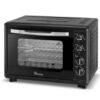
A Guide of Types of Baking Ovens
Baking is an art that requires precision, amongst other things, in terms of proper equipment. Any bakery or kitchen has to have one of the most important pieces of equipment: the oven. The type of oven used will affect the quality and consistency of the baked goods.
This blog examines the different kinds of baking ovens to help you make an informed decision about what exactly suits your needs.
Conventional ovens remain the most frequent oven type employed in the baking industry. These are the ones that can be located in most kitchen houses and thus remain the favorite for a home baker. They heat air inside the oven cavity using an electric or gas-powered heating element. Then it circulates through the food items, cooking all sides of food.
But where things start to get different with them is in a conventional oven. These are normally very versatile for baking cakes, cookies, and bread, as well as the roasting of meats. This sets them apart with one big possible disadvantage: heating inconsistency. One probable weakness would be inconsistencies in heat-up because sometimes baking items end up burnt on uneven surfaces, particularly big items. Heating could not even properly have its effect all over the interior portion; its improper way will cause parts in this portion to cook earlier compared to its interior section.
Convection ovens represent the upgraded edition of conventional ovens; they have the addition of an internal fan that circulates hot air inside the oven cavity. In this way, it promotes good heat distribution so that baked goods are well-dosed in temperature. Convection ovens have gained great favor among professional bakers because their cooking times are shorter and achieve very good results.
The most significant benefit of convection ovens is the ability to bake more than one tray at any given time and not have one set of items more under or overcooked compared to others. The fan promotes even heat distribution, perfect for sensitive items like meringues or soufflés. It does have a downside, though fan can cause many baked items to dry out, so you do need to keep a close eye on them while baking.
Deck Ovens
Commercial bakeries and pizzeria establishments use deck ovens. There are any number of stacked trays or decks that the food product sits on while it bakes. A deck oven cooks consistently from the bottom, suitable for baking products requiring a crusted exterior: bread, pizza, etc.
Deck ovens are designed to produce high-quality, artisan-style baked goods. The bottom heat gives a crisp crust, while the top heat ensures food is well-cooked. These ovens are generally powered by gas or electricity and come in single-deck and multi-deck versions. They are also very efficient since they can hold a large quantity of food items at one time.
Rotary Ovens
Another kind of oven widely used in most commercial bakeries is the rotary oven. Rotary ovens contain a rotating drum inside which the food to be baked is placed. This rotation exposes the food uniformly to heat, hence it bakes uniformly and at the same rate throughout.
Rotary ovens are used for high-volume baking operations and can bake a large amount of food at one time. They are used for the baking of bread, pastry items, and other bakery products. Because of the rotation of the drum, the heat inside the oven distributes evenly, therefore decreasing the chances of uneven baking. However, rotary oven tends to be very bulky and expensive, thus making them more suitable for commercial uses instead of home usage.
Tunnel Ovens
Large-scale industrial production most often relies on a type of oven known as a tunnel oven. They bake foods with constant movement through a heated tunnel powered by either gas or electricity. The food to be cooked rests on a continuous conveyor belt that transports the food through the oven and cooks it with consistent heat. These are very good for mass production, as they provide high-speed baking. Common food products that undergo baking in tunnel ovens include crackers, cookies, and bread. The continuous motion of the conveyor belt helps in baking the food evenly, since heat is also well-distributed, which means consistency in texture is achievable. In contrast, tunnel ovens are huge, expensive, and require high space consumption; hence, they are unsuitable for small-scale baking.
Wood-Fired Ovens
Wood-fired ovens have been in use for centuries and remain extremely popular today, especially in artisan bakeries and pizzerias. Heated by the burning of wood, these ovens add that unique smoky flavor to whatever food they are in. It is absorbed into the stone or brick walls of the ovens to acquire a constant baking temperature for the foods inside. The wood-fired oven can bake the food quickly at high temperatures, which is conducive for pizzas and bread. The high temperature gives it a crispy crust with a flavorful taste, keeping the inside soft and moist. However, the wood-fired oven requires constant attention to maintain the fire and temperature. They are also more labor-intensive and can be difficult to control; thus, they are a good area of work for experienced bakers.
Conclusion
The world of baking ovens is diversified; each type has its plus points. Starting from conventional ovens, right up to wood-fired ovens, all have their very specific applications for baking purposes. Each of them knows the use of various types of baking ovens, from home bakers to professionals, for their appropriate needs. The choice of oven depends on such factors as the volume of baking, the assortment of goods, and the owner’s budget. When you understand all the pros and cons of every type of oven, perfection in everything is achievable.



